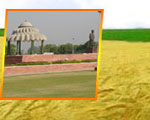| Encyclopedia of Tours and Travel to Haryana, featuring information on Fairs & Festivals, Wildlife, Excursion, Adventure & Weather of Haryana. |
 |
 |
 |
 |
 |
 |
 |
||
|
Sonipat
The district headquarter is situated in Sonipat. Other smaller towns are Gohana, Ganaur, Murthal and Rai. The total area of Sonipat district is 2,260 sq km and its population is 10,64,000. Sonipat is bordered by the states of Delhi and Uttar Pradesh as well as the districts of Rohtak, Jind and Panipat. The River Yamuna runs along the eastern boundary of the district. District Sonepat comprises of 3 sub-divisions namely Ganaur, Sonepat and Gohana and seven blocks (Ganaur, Sonipat, Rai, Kharkhoda, Gohana, Kathura and Mundlana) has been carved out of Rohtak and made a full fledged district on 22 December 1972. Sonepat is the largest tehsil followed by Gohana. Broadly speaking, the district is a continuous part of the Haryana-Punjab plain, but the area is not leveled in some parts. Over most of the district, the soil is fine loam of rich color. However, some areas has sandy soil and others are comprised of Kallar. The plain has a gradual slope to the south and east. The district may be roughly divided into three regions: The Khadar The Upland Plain
The Sandy Region Weather The cold season starts towards the later half of November when
day and night temperatures fall rapidly. January is the coldest
month when the mean daily minimum temperature is 6 to 7 Degree Centigrade
in the winter months. During ncold waves, the minimum temperature
may go down to the freezing point of water, and frosts can occur.
During the summer months of May and June, the maximum temperature
sometimes reaches 47 Degree Centigrade. Temperature drops considerably
with the advancement of monsoon in June. However, the night temperature
during this period continues to be high.
|
||||||||||
|
||||||||||
|
||||||||||
|---|---|---|---|---|---|---|---|---|---|---|